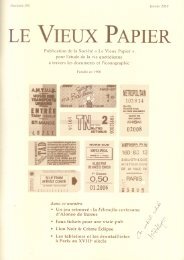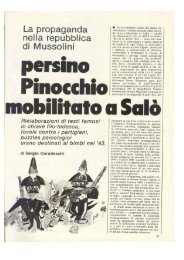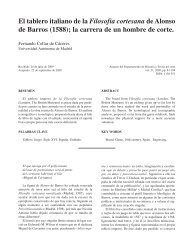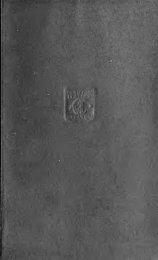Board games from the city of Vijayanagara (Hampi ... - Gioco dell'Oca.
Board games from the city of Vijayanagara (Hampi ... - Gioco dell'Oca.
Board games from the city of Vijayanagara (Hampi ... - Gioco dell'Oca.
You also want an ePaper? Increase the reach of your titles
YUMPU automatically turns print PDFs into web optimized ePapers that Google loves.
92<br />
B OARD G AME S TUDIES 6, 2003<br />
Nordenskiöld avait souligné la présence d’un vocabulaire emprunté au quechua,<br />
notamment pour les résultats des bâtonnets-dés: par exemple, en tapiete et en chulupi,<br />
on compte tsúka “1”, chimi (kima en choroti) “3”, tauva “4”, où l’on reconnaît les termes<br />
quechuas chunka “10” (pris pour 1) (8) , kimsa “3” et tawa “4” respectivement. Le savant<br />
suédois avait cru retrouver ce jeu mentionné dans l’Historia del Nuevo Mundo du père<br />
Bernabé Cobo (1653), sous le nom de chuncara (sur le jeu inca chunkana, voir Depaulis<br />
1998: 31). Poussant plus loin ses spéculations, Nordenskiöld était allé jusqu’à voir dans<br />
un objet composite, qui devait se révéler être un abaque (Depaulis 1998: 40-1), le tablier<br />
de ce jeu inca.<br />
Le rapprochement que j’opère ici entre le jeu du Chaco et la description de Vivar permet<br />
de penser qu’il s’agit pour l’essentiel du même jeu – un peu simplifié dans la version<br />
du Chaco – avec un dénominateur commun évident: le présence inca. Selon Margarita<br />
Gentile Lafaille, les terres basses du Chaco (quechua chako “terrain de chasse”) ont servi<br />
de refuge aux fonctionnaires incas après la chute de Cuzco (Gentile 1998: 111 avec réf.).<br />
On n’est donc pas surpris que les Indiens du Chaco pratiquent des jeux dont l’origine inca<br />
est hautement probable. Certains jeux se retrouvent aussi dans l’aire araucane, telle la<br />
chueca – sorte de hockey – qui est connue dans les deux cultures (Cooper 1949: 506-8.)<br />
Côté chilien, nous savons que la région du Mapocho était une colonie inca depuis<br />
le XVe siècle et qu’elle était soumise à un gouverneur venu du Cuzco. Dès avant la fondation<br />
de Santiago par Pedro de Valdivia en 1541, le site avait été une forteresse inca et<br />
l’arrière-pays avait de ce fait subi une importante influence culurelle. Ici aussi, le quechua<br />
avait servi de lingua franca. Il est raisonnable de penser que le jeu décrit par Vivar a été<br />
introduit dans la région par les Incas.<br />
Appendix<br />
English translation <strong>of</strong> Jerónimo de Vivar’s text:<br />
Chapter XCI which deals with a kind <strong>of</strong> game that <strong>the</strong> Mapocho Indians and all<br />
o<strong>the</strong>rs in this region have<br />
The way <strong>the</strong>se Indians play is thus: on <strong>the</strong> ground <strong>the</strong>y make a small place and, in a<br />
part <strong>of</strong> it, <strong>the</strong>y make a design like a C to <strong>the</strong> right and ano<strong>the</strong>r, reversed C facing [it].<br />
Between <strong>the</strong>se Cs, that is on <strong>the</strong> tops, <strong>the</strong>re is a small hole and, on each <strong>of</strong> <strong>the</strong>se two Cs,<br />
<strong>the</strong>re are 10 smaller holes. On <strong>the</strong>se <strong>the</strong>y set up stones, maize grains or small sticks, so<br />
that <strong>the</strong>y differ one <strong>from</strong> each o<strong>the</strong>r by <strong>the</strong> colour. Outside this circuit, <strong>the</strong>y stick a bracket<br />
3-span [high] [±30 cm] whose summit falls in <strong>the</strong> middle <strong>of</strong> this circuit <strong>of</strong> <strong>the</strong> Cs.<br />
With a twig <strong>of</strong> willow <strong>the</strong>y make an O fastened <strong>the</strong>reon, which will be as large as a bracelet.<br />
Those who want to play – two or four fellows – sit down; one cannot play with more<br />
than four. They take 4 white beans, because <strong>the</strong>se <strong>of</strong>fer more colours and <strong>the</strong>y make<br />
<strong>the</strong>m black on one side; <strong>the</strong>y throw <strong>the</strong>m through <strong>the</strong> willow twig that is on top, like a<br />
bracelet as I said. While throwing <strong>the</strong>m <strong>the</strong>y beat <strong>the</strong>ir breasts and right thighs with<br />
<strong>the</strong>ir hands – that is <strong>the</strong> same – speaking loudly. They [<strong>the</strong> beans] fall down on <strong>the</strong> place.







